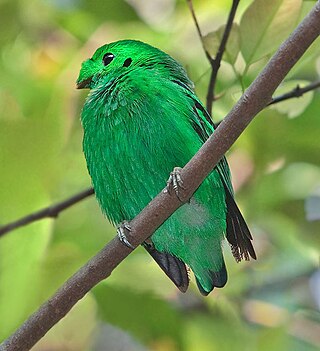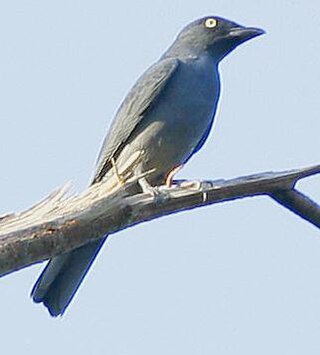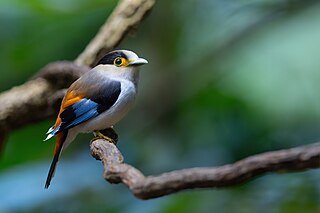
The long-tailed broadbill is a species of bird that is found in the Himalayas, extending east through Northeastern India to Southeast Asia. It is the only bird in the genus Psarisomus. The long-tailed broadbill is about 25 cm (10 inches) in length and weighs between 50 and 60 grams. It can be identified by its shrill call.

Calyptomena is a genus containing three green birds in the broadbill family Calyptomenidae that are found in Southeast Asia.

The collared kingfisher is a medium-sized kingfisher belonging to the subfamily Halcyoninae, the tree kingfishers. It is also known as the white-collared kingfisher, black-masked kingfisher or mangrove kingfisher. It has a wide range extending from the Red Sea across southern Asia to Polynesia. A number of subspecies and subspecies groups have been split from this species including the Pacific kingfisher, the islet kingfisher, the Torresian kingfisher, the Mariana kingfisher, and the Melanesian kingfisher.

The western hooded pitta is a passerine bird in the family Pittidae. It is common in eastern and southeastern Asia and maritime Southeast Asia, where it lives in several types of forests as well as on plantations and other cultivated areas. It is a green bird with a black head and chestnut crown. It forages on the ground for insects and their larvae, and also eats berries. It breeds between February and August, the pair being strongly territorial and building their nest on the ground. Incubation and care of the fledglings is done by both parents. The bird has a wide range, and the International Union for Conservation of Nature has assessed its conservation status as being of "least concern". It was formerly considered to be conspecific with the Nicobar hooded pitta, the Minahasa hooded pitta, the eastern hooded pitta and the Biak hooded pitta.

The Asian red-eyed bulbul is a member of the bulbul family of passerine birds. It is found on the Malay Peninsula, Sumatra, and Borneo. Its natural habitat is subtropical or tropical moist lowland forests.

The grey-bellied bulbul is a species of songbird in the bulbul family. It is found on the Malay Peninsula, Sumatra and Borneo. Its natural habitat is subtropical or tropical moist lowland forests. It is threatened by habitat loss.

The scaly-breasted bulbul is a species of songbird in the bulbul family. It is found from the Malay Peninsula to Borneo. Its natural habitat is subtropical or tropical moist lowland forests. It is threatened by habitat loss.

The hairy-backed bulbul is a songbird species in the bulbul family, Pycnonotidae. It is the sole species contained within the monotypic genus Tricholestes. It is found on the Malay Peninsula, Sumatra, and Borneo. Its natural habitat is subtropical or tropical moist lowland forests.

The thick-billed green pigeon is a species of bird in the family Columbidae.

The green iora is a species of bird in the family Aegithinidae. It is found in the Thai-Malay Peninsula, Sumatra and Borneo. Its habitats include lowland forests, secondary forest and mangrove forest. It is threatened by habitat loss, and the International Union for Conservation of Nature (IUCN) has assessed it as near-threatened.

Hose's broadbill is a species of bird in the family Calyptomenidae. It was described by the British naturalist Richard Bowdler Sharpe in 1892 and is named after the British zoologist Charles Hose, who collected the holotype of the species. It is 19–21 cm (7.5–8.3 in) long, with females weighing 92 g (3.2 oz) on average and males weighing 102–115 g (3.6–4.1 oz). Males are bright green and have conspicuous black spots on the wings, black markings on the head, blue underparts, black flight feathers, and a large green tuft covering most of the bill. Females have smaller forehead tufts, lime-green underparts with sky blue instead of azure blue on the undertail coverts, and lack black markings on the head, except for a black spot in front of the eye.

Whitehead's broadbill is a species of bird in the family Calyptomenidae. It is endemic to the mountain ranges of north-central Borneo, where it mainly inhabits montane forests and forest edges at elevations of 900–1,700 m (3,000–5,600 ft). It is 24–27 cm (9.4–10.6 in) long, with males weighing 142–171 g (5.0–6.0 oz) and females weighing 150–163 g (5.3–5.7 oz). Males are vivid green and have a black throat patch, black spots on the ear-coverts and back of the neck, and black markings and streaking all over the body. The tails and flight feathers are also blackish. Females are smaller and lack the black markings on the head and underparts. Juveniles look similar to adults but have fewer black markings.

The bar-bellied cuckooshrike is a species of bird in the family Campephagidae. It is found in Thailand, Malaysia, Indonesia, and the Philippines, and its natural habitats include mangrove forest, dry forest, swamp forest, and secondary forest. The plumage varies among the subspecies, with different amounts of barring on the underparts. The International Union for Conservation of Nature (IUCN) has assessed the species as one of least-concern.

The black-and-red broadbill is a species of bird in the typical broadbill family, Eurylaimidae. It is the only species in the genus Cymbirhynchus. A large, distinctive bird, it has maroon underparts, black upperparts, a maroon neck-band, and white bars on the wings. It also has a large, two-colored, blue-and-yellow bill. The species shows slight sexual dimorphism, with females being smaller than males. No other bird in its range resembles it, though the black-and-yellow broadbill has a similar call.

The banded broadbill is a species of bird in the Eurylaimidae typical broadbill family found in Mainland Southeast Asia and the Greater Sunda Islands. It is sometimes split into two species, one including only the nominate subspecies, E. j. javanicus, and one including all the remaining subspecies. It inhabits a variety of forests, along with forest edge, rubber plantations and Falcataria falcata groves, mainly in lowland areas. A striking, large-bodied bird with a length of 21.5–23.0 cm (8.5–9.1 in), it is unlikely to be mistaken for another species. The broadbill is mostly purplish-red, with yellow-streaked black wings, a bright blue beak, a blackish face and greyish chin and upper breast. Females can be told apart from males by their lack of a black neckband, although these are indistinct in Bornean and Javan males. Despite its conspicuous appearance, the bird is usually hard to see due to its sluggishness and is usually only noticed when it vocalises.

The black-and-yellow broadbill is a species of bird in the typical broadbill family Eurylaimidae. A small, distinctive species, it has a black head, breastband, and upperparts, a white neckband, yellow streaking on the back and wings, and vinous-pink underparts that turn yellow towards the belly. The beak is bright blue, with a green tip to the upper mandible and black edges. It shows some sexual dimorphism, with the black breastband being incomplete in females.

The fluffy-backed tit-babbler is a species of bird in the family Timaliidae. It is found in Brunei, Indonesia, Malaysia, and Thailand. Its natural habitats are subtropical or tropical moist lowland forest and subtropical or tropical swampland. It is threatened by habitat loss.

The dark-throated oriole is a species of bird in the family Oriolidae.

The silver-breasted broadbill is a species of bird in the broadbill family, Eurylaimidae that is found in parts of Southeast Asia. There are seven currently recognised subspecies; the other species in the genus Serilophus, the grey-lored broadbill, was also previously treated as being a subspecies of this species.

The grey-and-buff woodpecker is a species of bird in the family Picidae. It is found in Brunei, Indonesia, Malaysia, southern Myanmar, and southern Thailand, but has become regionally extinct in Singapore. Its natural habitats are lowland and montane tropical or subtropical moist broadleaf forests.























